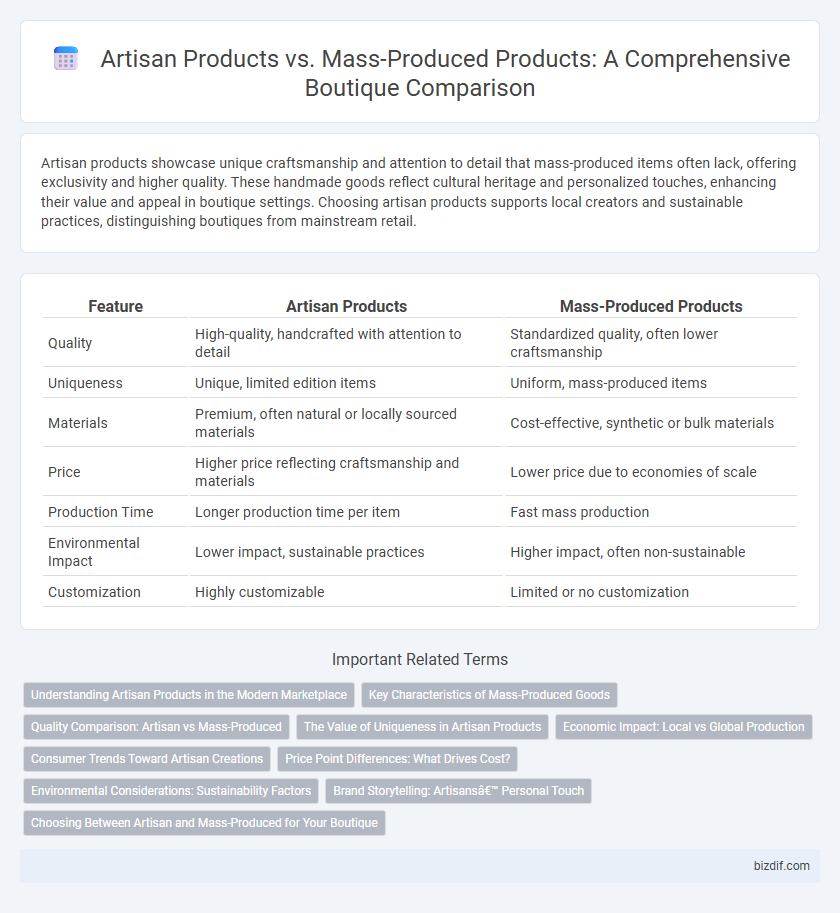Artisan products showcase unique craftsmanship and attention to detail that mass-produced items often lack, offering exclusivity and higher quality. These handmade goods reflect cultural heritage and personalized touches, enhancing their value and appeal in boutique settings. Choosing artisan products supports local creators and sustainable practices, distinguishing boutiques from mainstream retail.
Table of Comparison
| Feature | Artisan Products | Mass-Produced Products |
|---|---|---|
| Quality | High-quality, handcrafted with attention to detail | Standardized quality, often lower craftsmanship |
| Uniqueness | Unique, limited edition items | Uniform, mass-produced items |
| Materials | Premium, often natural or locally sourced materials | Cost-effective, synthetic or bulk materials |
| Price | Higher price reflecting craftsmanship and materials | Lower price due to economies of scale |
| Production Time | Longer production time per item | Fast mass production |
| Environmental Impact | Lower impact, sustainable practices | Higher impact, often non-sustainable |
| Customization | Highly customizable | Limited or no customization |
Understanding Artisan Products in the Modern Marketplace
Artisan products in the modern marketplace embody unique craftsmanship, often reflecting local culture and heritage, which mass-produced items lack. These goods are typically handmade using traditional techniques, ensuring higher quality and attention to detail that appeals to discerning consumers seeking authenticity. The growing demand for sustainable and ethically sourced products further elevates the value of artisan creations over mass-produced alternatives.
Key Characteristics of Mass-Produced Goods
Mass-produced products exhibit uniformity in design and quality due to automated manufacturing processes, enabling high-volume output at lower costs. These goods often prioritize functionality and consistency, with standardized materials reducing production variability. The scalability and efficiency of mass production make these products widely accessible but typically lack the unique craftsmanship and personalized detail found in artisan items.
Quality Comparison: Artisan vs Mass-Produced
Artisan products showcase superior craftsmanship with meticulous attention to detail, resulting in unique, high-quality items that often use premium materials and traditional techniques. Mass-produced products prioritize quantity and cost-efficiency, frequently sacrificing durability and individuality due to automated manufacturing processes. Quality comparisons consistently highlight artisans' commitment to excellence, distinguishing their products through enhanced longevity and aesthetic value.
The Value of Uniqueness in Artisan Products
Artisan products offer unparalleled uniqueness, reflecting skilled craftsmanship and personalized attention that mass-produced items lack. Each piece embodies distinct characteristics, often using high-quality materials and traditional techniques unavailable in large-scale manufacturing. This exclusivity enhances the perceived value, fostering emotional connections and supporting sustainable, local economies.
Economic Impact: Local vs Global Production
Artisan products stimulate local economies by supporting small-scale producers and fostering community craftsmanship, often resulting in higher employment rates and cultural preservation. Mass-produced products dominate global markets through large-scale manufacturing and distribution, reducing costs but often leading to job outsourcing and diminished local industry growth. The economic impact of boutique artisan goods emphasizes sustainability and local wealth retention, contrasting with the global economic efficiencies prioritized by mass production.
Consumer Trends Toward Artisan Creations
Consumers increasingly favor artisan products for their unique craftsmanship, authenticity, and sustainable production methods compared to mass-produced items. This shift reflects a growing demand for personalized, high-quality goods that support local artisans and reduce environmental impact. Market data shows a continuous rise in sales of handcrafted goods, driven by consumers valuing originality and ethical consumption.
Price Point Differences: What Drives Cost?
Artisan products typically command higher price points due to handcrafted techniques, premium raw materials, and limited production scales that emphasize quality and uniqueness. Mass-produced products benefit from economies of scale, automated manufacturing, and lower material costs, resulting in more affordable prices for consumers. The price difference is primarily driven by the intensive labor, craftsmanship, and exclusivity embedded in artisan goods compared to the standardized, high-volume nature of mass production.
Environmental Considerations: Sustainability Factors
Artisan products prioritize sustainability by using eco-friendly materials and traditional methods that minimize waste, unlike mass-produced items that often rely on synthetic materials and energy-intensive manufacturing processes. These handcrafted goods support local economies and reduce carbon footprints through limited transportation and responsible sourcing. Emphasizing durability and timeless design, artisan products contribute to long-term environmental benefits compared to disposable mass-produced alternatives.
Brand Storytelling: Artisans’ Personal Touch
Artisan products often feature unique characteristics and craftsmanship that mass-produced items lack, enhancing their appeal through authenticity and exclusivity. Brand storytelling emphasizes the artisans' personal touch, highlighting their skills, heritage, and creative processes to forge emotional connections with consumers. This narrative distinguishes boutique brands in the marketplace by showcasing dedication to quality and individual artistry.
Choosing Between Artisan and Mass-Produced for Your Boutique
Selecting artisan products for your boutique enhances uniqueness, quality, and supports local craftsmanship, appealing to discerning customers seeking exclusive items. Mass-produced products offer consistency, lower costs, and easier inventory management, suitable for high-demand, budget-conscious retail environments. Balancing artisan and mass-produced items optimizes product diversity, customer satisfaction, and profit margins in boutique retail.
Artisan products vs Mass-produced products Infographic

 bizdif.com
bizdif.com